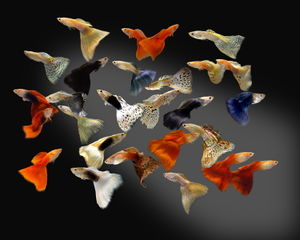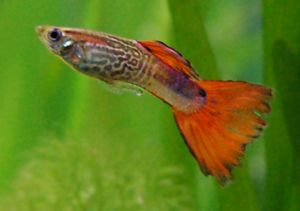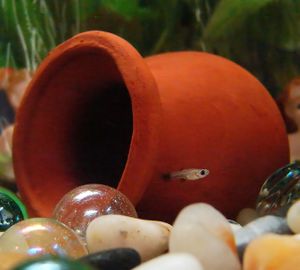Guppy
For years mankind has feared the Piranha and the Great White Shark and the dreaded Stingray oblivious to the most deadly fo all fish, the common guppy, which, for your information, can interbreed with the minnow.
History[edit | edit source]
Discovered in 1916 by Robert John Lechmere Guppy (1865-1916) and documented by his assistant Jahrence Cheung after a decent and Christian burial of his departed mentor, the Guppy was initially considered a natural anomaly a tiny and delicate fish who is capable of consuming a Man before he even has a chance of realizing he is being consumed, as was the case with Robert Guppy God rest his soul.
Distribution and Diversity[edit | edit source]
In its natural environment in South America and the Caribbean.In its native range, the guppy can be found in small streams and ponds of virtually any size. In Trinidad they are colloquially known as "Brazilions fish" because of their fecundity. In many countries with tropical, subtropical and mediterranea climates where guppies were not originally present, they have escaped from captivity and established naturally breeding ("feral") populations. It has also been erroneously introduced to some areas to keep down the mosquito population and help fight malaria,
Physical Description[edit | edit source]
The female guppy is most often drab brown to Olive Green in colour (though some females can have splotches of pink and lime green pokadots on them, this allows her to hide and thereby ambush her prey. The somewhat larger male has a naturally colourful caudal fin (tailfin), showing a wide variety in the wild, This coloration serves a similar purpose as the vibrant coloration of South American Poison Dart Frogs. The Guppy has approximately 345 tiny razor sharp teeth lining its mouth these are continually being replaced as they fall out during feeding frenzies. Guppy have a strong pectoral fins that help them climb the aquarium, so it is advisable to cover your aquaria.
Ecology and behaviours[edit | edit source]
In the wild the Guppy is a constantly moving and hungry predator, any animal setting foot within the water where a Guppy lives is immediately set upon and devoured, after experiments during World War II by Japanese scientists it was found that a pack of 20 guppies can reduce a human of 200 lbs. to his skeleton within an average of fifteen minutes, it can also suck the gelatinous out of a fully sized schkwowtum in two seconds. the guppy is continually stalking the outer perimeters of its territory, and can sense prey based on vibrations in the water and by the smell of blood, sweat or other bodily excretions that come into contact with the water.
Guppy standards[edit | edit source]
The Guppy is known for its assorted Tail configurations all designed by generations of Eviloution to provide their bearers with the most efficient killing tools.
- A) Long Hatchet, this pattern is designed for distance killing, the fish can swim in reverse using its tail chop off chunks of flesh from its prey
- B) Short Hatchet, This pattern is usually found on larger males, the heavier blade needs less ramming speed to lop off chunks of flesh
- C) Scottish Hatchet, Much like B, this Hatchet operates similarly, but the guppy so equipped is usually Drunk.
- D) Butchers Cleaver, primarily used in a chopping motion to cut through bone and grisle
- E) Frogs Gig, this breed of guppy is actually the least dangerous, as its tail is dedicated to the consumption of Frogs.
- F) Top Sting, This Breed is one of the Two venomous breeds, the spine on top of the tail contains a powerful neurotoxin which renders its prey immobile but increases Agony of the pain of being eaten
- G)Bottom Sting, like its Cousin F, this guppy is poisionous, however it posses a violent Necrotoxin that begins dissolving its prey on contact.
- H) Lyretail
- I) Tailless, this is a Needletail after shooting its quill,
- J) False Stingtail, this breed while it posses a sting possesses no venom, but it makes up for it by first eating the genitiles of its victims after soundly hitting them in them.
- K) Buzzsaw tail, the rotating tail of this breed is covered with tiny sharp projections and serve the same purpose as a circular saw.
- L) Needletail, the spine in the middle of this fish's tail can be shot from its tail and into the victim, it can pierce up to 3 inches into a watermelon, and upon contact with warm flesh, Explodes.
- Any mixture of the above - in 1937 scientist Sponngje Bobbinsyn experimented by cross breeding different tail types, resulting in very variable fish, some of which became herbivores and blood-suckers, others developed multiple tails and other fins, while others spontaneously exploded or had cardio arrest when startled.
Reproduction[edit | edit source]
The Guppy is not alone in nature with its odd breeding habits, much like the mosquito which must dine on blood before she can lay her eggs, the guppy female must consume hundreds of baby guppies from her last spawning prior to spawning her 20 or so live born offspring, it is believed that the guppy young ingested is what makes the newly born fry capable of flying in the air for short distances.
If the fish, born at a mere 50/100 of an inch long can escape adult guppies, they will mature and grow to their full two inches long in a few years and search out mates. The female consumes his remains, she gives birth a month later.











